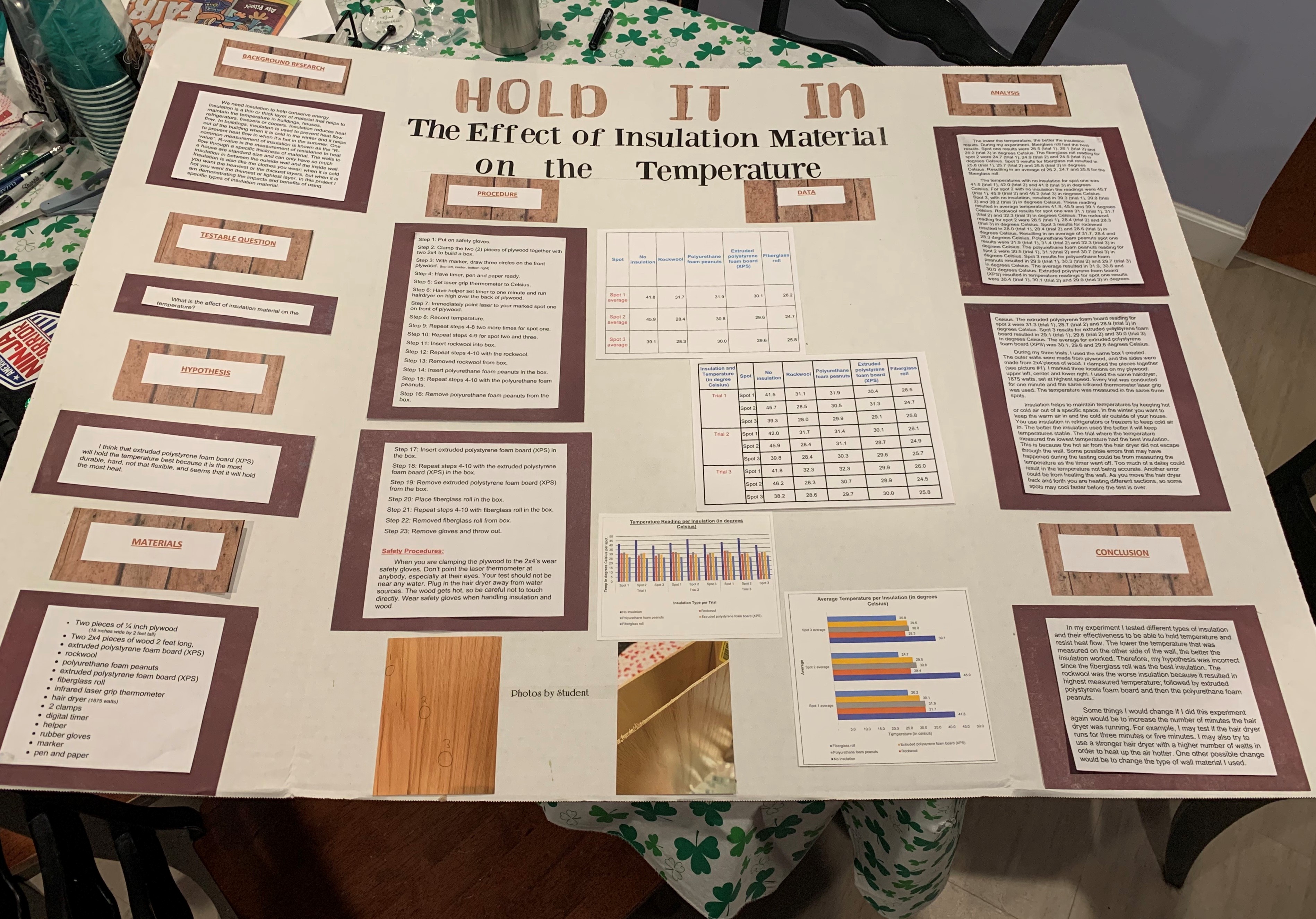HOLD IT IN - The Effect of Insulation Material on the Temperature
Abstract:
Insulation helps to maintain temperatures by keeping hot or cold air out of a specific space. The trial where the temperature measured the lowest temperature had the best insulation. This is because the hot air from the hair dryer did not escape through the wall. In this experiment I tested different types of insulation and their effectiveness to be able to hold temperature and resist heat flow. The lower the temperature that was measured on the other side of the wall, the better the insulation worked. During my experiment, fiberglass roll had the best results. During my three trials, I used the same box I created. The outer walls were made from plywood, and the sides were made from 2x4’pieces of wood. I clamped the pieces together (see picture #1). I marked three locations on my plywood: upper left, center and lower right. I used the same hairdryer, 1875 watts, set at highest speed. Every trial was conducted for one minute and the same infrared thermometer laser grip was used. The temperature was measured in the same three spots.
Bibliography/Citations:
No additional citationsAdditional Project Information
Project files
Research Plan:
We need insulation to help conserve energy. Insulation is a thin or thick layer of material that helps to maintain the temperature in buildings, houses, refrigerators, freezers or coolers. Insulation is also like the clothes you wear; when it is cold you want the heaviest or the thickest layers, but when it is hot you want the thinnest or lightest layer. Insulation reduces heat flow to maintain temperature. In this project I am demonstrating the impacts and benefits of using specific types of insulation material.
Materials:
- Two pieces of ¼ inch plywood (18 inches wide by 2 feet tall)
- Two 2x4 pieces of wood 2 feet long,
- extruded polystyrene foam board (XPS)
- rockwool
- polyurethane foam peanuts
- extruded polystyrene foam board (XPS)
- fiberglass roll
- infrared laser grip thermometer
- hair dryer (1875 watts)
- 2 clamps
- digital timer
- helper
- rubber gloves
- marker
- pen and paper
Procedure
Step 1: Put on safety gloves.
Step 2: Clamp the two (2) pieces of plywood together with two 2x4 to build a box.
Step 3: With marker, draw three circles on the front plywood. (top left, center, bottom right)
Step 4: Have timer, pen and paper ready.
Step 5: Set laser grip thermometer to Celsius.
Step 6: Have helper set timer to one minute and run hairdryer on high over the back of plywood.
Step 7: Immediately point laser to your marked spot one on front of plywood.
Step 8: Record temperature.
Step 9: Repeat steps 4-8 two more times for spot one.
Step 10: Repeat steps 4-9 for spot two and three.
Step 11: Insert rockwool into box.
Step 12: Repeat steps 4-10 with the rockwool.
Step 13: Removed rockwool from box.
Step 14: Insert polyurethane foam peanuts in the box.
Step 15: Repeat steps 4-10 with the polyurethane foam peanuts.
Step 16: Remove polyurethane foam peanuts from the box.
Step 17: Insert extruded polystyrene foam board (XPS) in the box.
Step 18: Repeat steps 4-10 with the extruded polystyrene foam board (XPS) in the box.
Step 19: Remove extruded polystyrene foam board (XPS) from the box.
Step 20: Place fiberglass roll in the box.
Step 21: Repeat steps 4-10 with fiberglass roll in the box.
Step 22: Removed fiberglass roll from box.
Step 23: Remove gloves and throw out.
Safety Precautions:
When you are clamping the plywood to the 2x4’s wear safety gloves. Don’t point the laser thermometer at anybody, especially at their eyes. Your test should not be near any water. Plug in the hair dryer away from water sources. The wood gets hot, so be careful not to touch directly. Wear safety gloves when handling insulation and wood.

